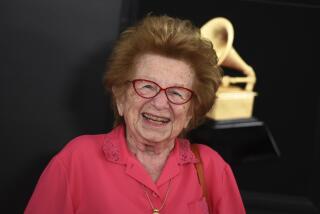Esther M. Broner dies at 83; Jewish feminist, novelist
Esther M. Broner, a Jewish feminist whose egalitarian vision led her to create a Passover Seder and other Jewish ceremonies that emphasized women’s perspectives, died June 21 in New York City. She was 83.
The cause was multiple organ failure from an infection, said her daughter, Nahama Broner.
The author of 11 books, including four novels, Broner was best known for “The Women’s Haggadah,” which combined feminist commentaries, songs and other activities in a new ritual recognizing women’s role in the commemoration of the ancient Israelites’ exodus from Egypt. Written with Naomi Nimrod and originally published in Ms. magazine, it is the most influential of Broner’s books dealing with Jewish ceremony.
In 1976 Broner became the spiritual leader of a feminist Seder in New York that included Gloria Steinem, Phyllis Chesler, Grace Paley, Bella Abzug and other leading figures of the women’s movement. Calling themselves the “Seder Sisters,” they convened for three decades, altering the ceremony each year by focusing on a new theme and incorporating personal stories.
Broner described the origins and evolution of the feminist Seder in “The Telling: The Story of a Group of Jewish Women Who Journey to Spirituality Through Community and Ceremony” (1993).
In reaction to the traditional Seder in which women prepared the Passover meal while men performed the rituals, the feminist Seder admitted no men. Broner and her Seder sisters referred to God as “She,” honored Miriam, Moses’ sister, as an alternative to the prophet Elijah, and sang songs, such as this one by Broner:
This holiday we take for ourselves,
no longer silent servers behind the curtain,
but singers of the Seder,
with voices of gladness,
creating our own convocation,
and leaving “The Narrow Place” together.
They also took an inventive approach to the portion of the evening devoted to recalling the 10 plagues God inflicted on the Egyptians.
With women doing the telling, there were always more than 10 plagues, “columns of them, a whole portico, enough to describe a dysfunctional society,” Broner wrote. “They called out: Silicone Implants; Homophobia; Crown Heights Racial Strife; The Rape Trials of the Accused — William Kennedy Smith, Mike Tyson …; Size of the Military Budget; Massacre by Hussein; Death Penalty; Women with Breast Cancer.”
Ms. published the feminist Haggadah in 1977, but Jewish presses turned it down. “The Women’s Haggadah” was finally published by HarperSanFrancisco in 1994. It inspired women around the world to hold their own Seders.
“This really was the beginning for those who wanted to take the feminism that had empowered them in secular areas into the religious area,” said feminist psychologist Chesler in an interview last week.
Broner, who was born in Detroit on July 8, 1927, was the daughter of Paul Masserman, a journalist and Jewish historian, and Beatrice Weckstein, who had acted in the Yiddish theater in Poland. She earned a bachelor’s degree in English and a master’s in creative writing from Wayne State University before joining its faculty in 1964 and teaching there for two decades. She earned a doctorate in religion from what is now the Union Institute & University in Cincinnati and was a visiting professor at a number of campuses, including UCLA and University of Haifa in Israel. She was also a professor at Sarah Lawrence College.
As a fiction writer, Broner wrote in an experimental style and portrayed women in mythic terms. Of her novels, “A Weave of Women” (1978) earned particularly high marks. John Leonard of The New York Times called it “an astonishment.”
When Broner’s father died in 1987, she went to the Orthodox synagogue near her home in Manhattan to recite the Kaddish, the Jewish prayer for the dead. Every morning for the requisite 11 months she waited for a minyan, a group of at least 10 men, to be present before she could begin to pray. Then, in accordance with Orthodox practice, she had to stand behind a partition called the mechitza that kept her separate from the men.
As she recounted in “Mornings and Mourning: A Kaddish Journal” (1994), she registered her disapproval of the inequality. She made herself stand out even more by wearing garish purple and green outfits. The men erected bigger partitions. At one point, after they hung a thick shower curtain to block her out, Broner took a swim cap from her gym bag and pulled it over her head.
She was married for 62 years to Robert Broner, a painter and printmaker; her death came a year and a day after his. She is survived by two daughters, two sons, and two grandchildren.
More to Read
Start your day right
Sign up for Essential California for the L.A. Times biggest news, features and recommendations in your inbox six days a week.
You may occasionally receive promotional content from the Los Angeles Times.





















































